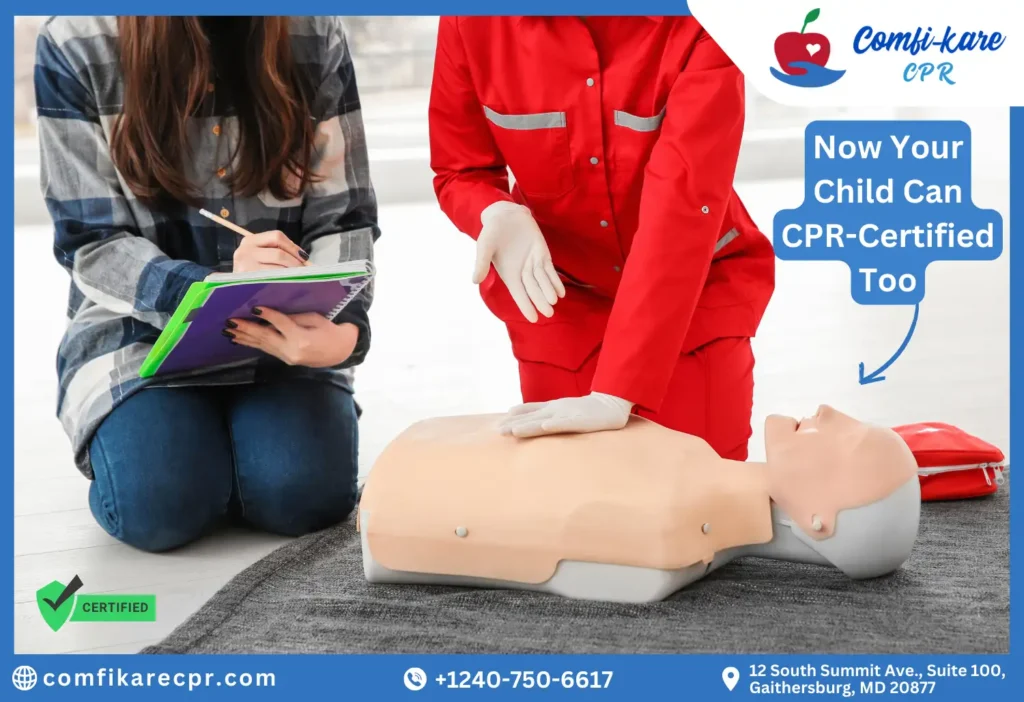
As a parent, you are always scared to leave your child alone at home. You rely on an adult to care for them and help them feed, bathe, or make them sleep on time. But what happens if the adult who is solely responsible for caring for your child suddenly has a cardiac arrest? Imagine how terrifying it gets for your child when the adult caring for them faints suddenly in front of them.
In such a case, what should you do? Wouldn’t it be amazing if your child knew how to deal with a medical emergency? Learning about cardiopulmonary resuscitation (CPR) empowers them to be the first responders during such desperate times.
Now, your mind must be racing with various thoughts:
- “Is my child old enough to learn CPR?”
- “Will they be scared to perform it?”
- “Is my child fit to perform CPR?”
- “Are the CPR instructors qualified enough to teach my kid?”
Don’t worry, we are going to address all these questions one by one in this blog. So, by the end of the blog, you will notice the power of CPR to make your child a potential lifesaver.
Is my child old enough to perform CPR?
It is a genuine question for most parents because they feel that their children are not strong enough to perform CPR techniques. However, what they don’t know is that early exposure to CPR can benefit children aged 4 to 8 years.
Children of this age group can express themselves when an emergency arrives and do some age-appropriate activities to save a life. Being familiar with various medical emergencies helps them make important decisions and take the right steps to make a difference. It includes making an emergency call to 911, providing first aid, etc.
The formal CPR training starts at the age of 9 to 12 years. They are the first to perform CPR and recognize the signs and symptoms of cardiac arrest. In Frederick County, MD, various institutions provide different CPR courses for this age group; therefore, they understand the dos and don’ts of hands-on CPR.
With age-appropriate teaching methods, they earn various certifications in CPR that empower them to become first responders. So, whenever a medical emergency occurs, CPR in just 10 steps saves an individual.
Next comes the role of emergency preparedness among teenagers beyond the age of 13. In the CPR class, they learn about AED usage, choking, airway management, and common CPR mistakes. Practical knowledge of various medical emergencies is essential to making them feel confident about the right decision to take during a medical emergency.
Additionally, if they have completed CPR certification, it is important to enroll them in CPR recertification too. This helps them refresh their skills and take note of some important updates on the CPR training.
Also, children with limited abilities can perform CPR. Yes, there are alternative CPR techniques for children who have physical limitations. This includes one-hand CPR, seated CPR and using chest compression devices to mitigate their strength limitations. The same goes for rescue breathing, where children use barrier devices, bag-valve masks, hands-on CPR, and so forth.
“Will they be scared to perform it?”
Parents are concerned and ask CPR instructors whether their child is scared when performing it. A parent once asked our CPR instructor, “Will my child be scared to perform CPR during a medical emergency?”
To this, the instructor answered, “If the child encounters it for the first time, there can be a sense of discomfort and hesitance in the first instance. However, we provide enough training and a stimulating environment to help children develop confidence to perform CPR efficiently during a medical emergency.”
Comfikare CPR understands sensitivity and, therefore, helps children build confidence and adds a sense of responsibility to become better people. So, if ever a medical emergency occurs, they can be the first responders to perform CPR on an individual.
“Is my child fit to perform CPR?”
Our CPR instructors ensure that children who are being taught CPR must have the strength to perform it. Moreover, by performing in a stimulating environment, they understand their mistakes and try to overcome them.
Therefore, it is important for children to feel confident. Based on the strength of a child, our CPR instructors provide age-appropriate techniques to help children know their true potential to become lifesavers. Besides, learning CPR helps children develop skills and knowledge about various medical emergencies and act promptly during an emergency.
“Are the CPR instructors qualified enough to teach my kid?”
You will find many qualified CPR instructors to teach children about various CPR techniques. They measure the strength of a child, and based on their physical and mental capabilities, they teach students about this.
Bottom Line,
Cardiopulmonary resuscitation helps restore the life of an individual with the right chest compression techniques. However, an individual will make several mistakes initially. However, with the right practice, one can overcome them. Therefore, the parents must understand that they need to be supportive during the CPR learning journey of their little ones. This instills a sense of confidence and helps them be better prepared during an emergency.



